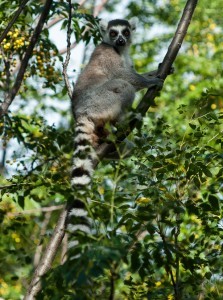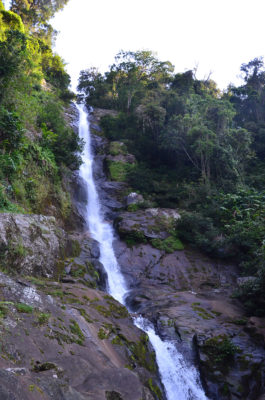
Lemurs and Madagascar are unique in many ways. On this page, learn how lemurs evolved and why they are special.
- Lemurs live in Madagascar, and nowhere else.
- Lemurs are the world’s oldest living primates.
- Lemur ancestors likely landed on the island of Madagascar about 70 million years ago.
- There are over 100 species of lemurs.
- Lemurs have unique physical characteristics.
- As seed dispersers, lemurs are creators of the forest.
- Lemurs need our help to be saved from extinction.
Why are lemurs so interesting?
Lemurs live in Madagascar, and nowhere else.
In fact, about 90% of the island’s fauna and flora is found nowhere else! Lemurs evolved separately from other primates on the Indian Ocean island of Madagascar, located off the east coast of Africa. Madagascar is full of unique landscapes, from limestone pinnacles called tsingy to lush, green rainforests to spiny deserts and impressive canyons. Lemurs aren’t the only critters in Madagascar that are unique.
Lemurs are the world’s oldest living primates.
Lemurs are part of a group of primates referred to as Strepsirrhini (wet-nosed primates), which include the species most similar to ancestral primates. This makes lemurs a fascinating link to the ancestral evolution of other primates, including humans!

Lemur ancestors likely landed on the island of Madagascar about 70 million years ago.
The story of the lemurs begins 65 to 75 million years ago. This is when lemur-like animals, the planet’s first primates, roamed Africa along with the dinosaurs.
Lemurs Originated in Mainland Africa
Fossil records indicate that the common ancestor of lemurs originated in Africa, not on the island of Madagascar. No fossil records have been found on Madagascar that would show an evolutionary link between animals that were on Madagascar during the pre-Cenozoic era and the lemurs we know today. So, scientists believe lemurs must have evolved from ancestral primates on Africa’s mainland. Perhaps because these mammals were small and nocturnal, they were able to survive among large predators like dinosaurs.

How did lemurs get to Madagascar?
Since lemurs are only found on Madagascar now, the lemur ancestors must have found a way to get from the mainland of Africa to the island of Madagascar. It’s believed they did so by rafting across the Mozambique Channel on floating mats of vegetation!
Scientists hypothesize that when lemurs completed this journey, the water current of the channel actually flowed from Africa to Madagascar. This is different from the current direction today. The small size of the ancestral lemurs and their ability to vary between endothermic and ectothermic helped them survive the trip across the Indian Ocean to colonize Madagascar.
Lemurs Evolved over Millions of Years
Over the next tens of millions of years, lemurs evolved and diversified into the most varied group of primates on Earth. Some were even the size of gorillas! The smaller species that have survived make up the present day lemurs. They are the oldest living primates left in our world, and the last living link to human’s evolutionary past.
There are over 100 species of lemurs.

There are an estimated 112 species of lemurs today.
Variety of Species
These species have a significant range in size, from the 30g Madame Berthe’s mouse lemur to the up to 9kg indri. The total number of species changes regularly when new species are identified.
Lemurs responded to the lack of large predators as well as Madagascar’s unique landscapes and their variety of food sources by evolving into over 100 unique species. This includes the ring-tailed lemur with its furry, striped tail, the dancing sifakas that leap sideways through the trees, and the goblin-like nocturnal aye-aye which uses its long middle finger to dig for food.
Subfossil discoveries of extinct lemur species tell us there was even greater diversity before. It is believed that one extinct lemur species was the size of a gorilla! Hunting may have led to the extinction of this and other species after the arrival of humans on the island approximately 2,000 years ago.
Lemurs have unique physical characteristics.

Lemurs are a diverse group of primates, but share several common traits. These traits distinguish them from other types of primates, like monkeys and apes. What are their unique characteristics?
Sense of Smell
Lemurs communicate in various ways, but their sense of smell is particularly unique. Compared to many other primates, they have longer snouts and wet noses that help them communicate with smell.
Night Vision
Lemurs also use vision less primarily than other primates. But, they do have improved night vision due to the retained extra layer of tissue behind the retina in the eye. This is called the tapetum lucidum. The fact that lemurs have improved night vision indicates that their ancestors were likely nocturnal.
Built for Grooming
Lemurs have forward leaning (rather than upward) incisors and canine teeth. This is called a toothcomb and is seen in all existing lemur species except the aye-aye. Toothcombs are an ancestral characteristic unique among primates to the lemuriformes. They are used for grooming and sometimes for feeding on seeds or bark. Lemurs also have a grooming claw, a specialized nail on their second digit.
As seed dispersers and pollinators, lemurs are creators of the forest.

Lemurs create and maintain Madagascar’s forests because they pollinate plants and disperse seeds which help the forest grow.
But, how are they seed dispersers?
Many lemurs love to eat fruit. When they eat fruit, they cannot digest the seeds. The seeds leave the lemur’s body in their droppings or feces. As lemurs travel throughout the forest, they spread their droppings, which spreads the seeds in their own natural fertilizer. Eventually, these seeds grow new trees, providing shelter and food not only for the lemurs, but also for snakes, chameleons, geckos, and even fossas.
Lemurs need our help to be saved from extinction.
According to the 2020 IUCN Red List Update, 98% of lemur species are endangered. And, 31% of species are critically endangered, which is one step away from extinction in the wild.
How can we help lemurs?
If we all work together, we can help Madagascar’s lemurs and other unique wildlife thrive for generations to come. Visit our How to Help page to find many ways you can help. These include donating, volunteering, traveling to Madagascar, making sustainable choices at home, and even switching your search engine!
How You Can Help